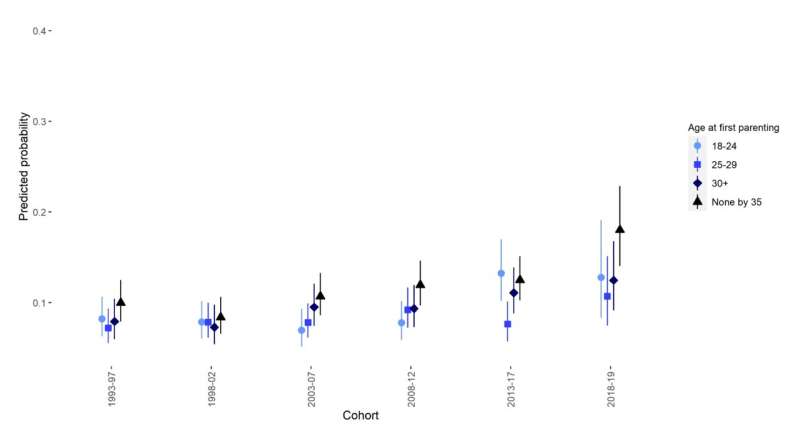Women without children at age 35 are at highest risk of binge drinking, alcohol use disorder, finds study


Excessive drinking and alcohol-related deaths are increasing at an alarming rate among women, particularly among reproductive-aged women in their late 20s and 30s. Traditionally, women tend to reduce their alcohol consumption once they have children, but in recent years, more middle-aged women have delayed or skipped motherhood.
This growing trend in women who are delaying or foregoing parenting is contributing to an increase in women at highest risk for excessive alcohol use, according to a new study led by Boston University School of Public Health (BUSPH).
Published in the journal Addiction, the study found that women who turned 35 in recent years, as well as women who have not had children by age 35, are the subgroups of women at highest risk of binge drinking and having alcohol use disorder (AUD) symptoms.
The study is the first to consider the impact of delayed parenting on excessive alcohol use among newer generations of middle-aged women. The findings underscore the need to address excessive drinking among all women, but particularly among this expanding group of women without children.
“Because more women are delaying having children in the US, a growing proportion of women fall into the highest risk group,” says study lead author Dr. Rachel Sayko Adams, research associate professor of health law, policy & management at BUSPH. “This growing prevalence of heavy drinking is exacerbated given that excessive alcohol use is increasing overall for middle-aged women in more recent cohorts. Therefore, at-risk alcohol use and consequences are expected to continue increasing in future years, if not addressed.”
Compared to men, the consequences among reproductive-age women who binge drink or develop AUD include an increased risk for liver disease, alcohol-related injuries, and breast cancer, along with sharper increases in alcohol-related mortality.
For the study, Dr. Adams and colleagues examined data from Monitoring the Future, an annual, ongoing survey of high school students’ substance use behaviors in the US. Nearly 10,000 self-identified women participants completed a survey at age 35 between 1993 and 2019, corresponding to high school senior years between 1976 to 2002.
The participants shared their parental status, age of first-time parenting, and whether they engaged in binge drinking (defined as consuming four or more drinks in one setting) in the past two weeks, or developed AUD symptoms in the past five years.
Women who turned 35 between 2018 and 2019 were nearly 60 percent more likely to binge drink or report AUD symptoms than women who turned 35 between 1993 and 1997. The trend towards parenting at older ages was evident, as only 39 percent of women in the 2018-2019 cohort had children before age 30, compared to 54 percent of women in the 1993-1997 cohort.
The researchers cite several societal and cultural changes that are influencing these simultaneous increases in delayed parenting and excessive alcohol consumption among older women. Many women decide to postpone motherhood to pursue higher education and establish a career; the findings showed that the most recent group of 35-year-old women were nearly twice as likely to complete four years of college than the 35-year-olds in the 1990’s.
The researchers state that one of the most significant drivers of unhealthy alcohol use among women today is the widespread acceptance and normalization of alcohol consumption in daily life in the US—from social and professional settings, to casual drinking at home. Although the study shows that middle-aged women without children were at highest risk of unhealthy drinking, women with children were also at an increased risk, particularly in more recent cohorts.
This public embrace of alcohol may be influenced in part by social media-driven “wine-mom” culture, which encourages mothers to drink to cope with the challenges of motherhood and work, and for recreational enjoyment.
“Alcohol industry messages around drinking for stress relief and enjoyment have always been part of the industry’s advertising strategy, and we’ve seen this emerge on social media platforms, particularly geared towards people who parent,” says study senior author Dr. Katherine Keyes, professor of epidemiology at Columbia University Mailman School of Public Health.
“Promotion of alcohol use for moms to deal with the stresses of motherhood in Facebook and Instagram groups have common hashtags such as #winemom, #sendwine, and #mommyjuice. Simultaneously, there has been a rapid increase in alcohol products targeting middle-age women—such as low-calorie seltzers, pink beverages, and expressions such as ‘rosé all day.'”
Knowledge about how these cultural changes may be impacting women’s drinking behaviors is very limited due to little research, Dr. Adams says. “Yet, the potential consequences of ‘wine mom’ culture may be that normalizing drinking to cope with the stresses of motherhood is risky. Studies have shown that drinking to cope with stress increases risk for AUD.”
Since excessive drinking is increasing for middle-aged women with and without children, it is critical for the public health community to develop approaches and interventions that appeal to all middle-age women, she says.
“More research is needed to understand the impacts that social media messages and groups targeting women have on women’s drinking behaviors, as well as the role of alcohol products targeting women,” says Dr. Adams.
It is also important to continue monitoring trends in alcohol use. Alcohol-related deaths increased sharply during the COVID-19 pandemic.
“More support for women who parent, such as facilitating social connections and increasing support for workplace mothers, may reduce drinking to cope with the stresses of motherhood,” Dr. Adams says. “Efforts should be made to improve access to AUD treatment for women and mothers, including addressing stigma, increasing women-focused treatment settings, and expanding flexible treatment options.”
More information:
Rachel Sayko Adams et al, Cohort effects of women’s mid‐life binge drinking and alcohol use disorder symptoms in the United States: Impacts of changes in timing of parenthood, Addiction (2023). DOI: 10.1111/add.16262
Journal information:
Addiction
Source: Read Full Article